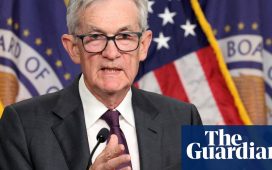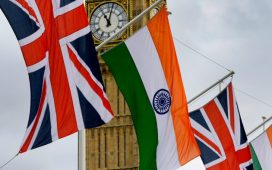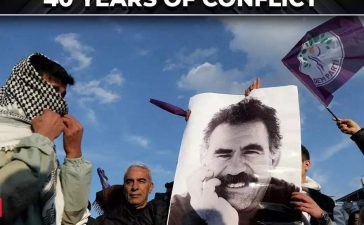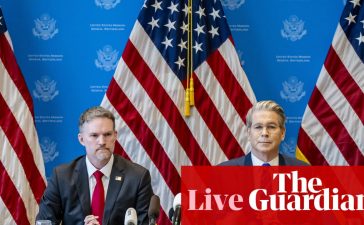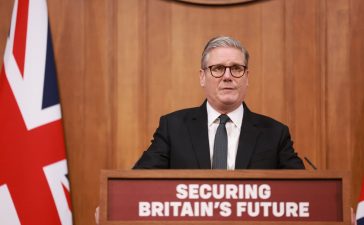Stay informed with free updates
Simply sign up to the US interest rates myFT Digest — delivered directly to your inbox.
Jay Powell has signalled he is ready to cut US interest rates in September, as he warned that “downside risks” to the labour market had increased.
“The time has come for policy to adjust,” the Federal Reserve chair said in a hotly anticipated speech in Jackson Hole, Wyoming, on Friday. “The direction of travel is clear, and the timing and pace of rate cuts will depend on incoming data, the evolving outlook, and the balance of risks.”
US Treasuries rallied and the dollar fell as investors bet on larger Fed rate cuts this year.
Powell said the Fed would do “everything we can to support a strong labour market as we make further progress towards price stability”. In comments that buoyed stock markets, he warned that “the upside risks to inflation have diminished, and the downside risks to employment have increased”.
The remarks at the Kansas City Fed’s annual symposium were the US central bank chair’s strongest signal yet that it will soon cut interest rates from their current 23-year high of 5.25-5.5 per cent.
The Fed next votes in mid-September, six weeks before the US presidential election. The economy, inflation and high borrowing costs have been major concerns for American voters, damaging President Joe Biden’s approval ratings.
The two-year Treasury yield, which reflects interest rate expectations, fell 0.1 percentage points to 3.91 per cent. The dollar was down 0.8 per cent against a basket of rival currencies. In stock markets, the S&P 500 ended the day up 1.2 per cent, closing in on July’s all-time high.
Markets are now pricing in a roughly 35 per cent probability of a larger than usual half percentage point rate cut next month, compared with around 28 per cent before Powell spoke.
Republican presidential nominee Donald Trump recently warned Powell not to cut rates before the vote. But some economists and Democratic lawmakers have already accused the Fed of moving too slowly, raising the risks of recession.
Interest rate cuts would align the US central bank with many of its peers, which have also eased monetary conditions as inflation has fallen across developed economies.
The European Central Bank lowered its key deposit rate by a quarter point in June to 3.75 per cent — the first cut in almost five years — before holding firm in July. Two additional quarter-point cuts are expected this year.
In a knife-edge vote in August, the Bank of England also reduced its policy rate, although governor Andrew Bailey pushed back on the idea of a successive string of cuts.
Powell said inflation had declined “significantly” since an unexpected flare-up at the start of the year, to an extent that his “confidence has grown that inflation is on a sustainable path” back to the Fed’s 2 per cent goal.
Price pressures have eased without a sharp rise in job losses, defying many economists’ predictions of a downturn in the world’s largest economy.
Powell said the Fed did “not seek or welcome further cooling in labour market conditions”, which he said had “cooled considerably from its formerly overheated state”. He expressed confidence that the Fed could achieve a soft landing, hitting its inflation goal without causing undue economic harm.
While US businesses are adding fewer jobs and the unemployment rate has increased, much of its rise to 4.3 per cent can be attributed to an influx of new workers entering the labour pool, economists say.
Still, annual revisions released by the Bureau of Labor Statistics this week showed jobs growth had been far weaker over the year to March than originally stated.
Other Fed officials have signalled they would prefer to cut rates gradually, by a quarter point, rather than more aggressive half-point moves. However, they have suggested that larger cuts could follow if the labour market weakens dramatically.
Powell said that the Fed had “ample room to respond to any risks we may face, including the risk of unwelcome further weakening in labour market conditions”.
He also gave his most detailed assessment to date of why inflation had surged and how it has come down seemingly painlessly. He also explained why the Fed originally thought the rise in inflation would prove shortlived.
Powell attributed the bulk of the increase in prices to “an extraordinary collision between overheated and temporarily distorted demand and constrained supply”.
Aggressive action from the central bank, in the form of a string of big interest rate increases, were instrumental in bringing it down. “The FOMC did not flinch from carrying out our responsibilities,” he said.
Later this year, the Fed will begin a review of its monetary policy strategy — a process that occurs every five years. The last review in 2020 saw the rollout of a framework that sought to make up for the prolonged period before the pandemic in which inflation ran below 2 per cent.
Powell said on Friday that the Fed would be “open to criticism and new ideas, while preserving the strengths of our framework”.





